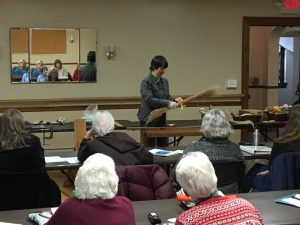Over the past year, I have had several opportunities to demonstrate flax processing and talk about natural dyeing. Here is a quick summary of four events that I didn’t get around to writing about when they happened. I just want to document and share them before too much more time passes.
Last August (2016) I did a flax processing demonstration at the Amherst History Museum, in conjunction with the art exhibit “Artifacts Inspire” by the Fiber Artists of Western Massachusetts. The museum asked the participating artists to create original works inspired by objects in the museum’s collection. Two of the pieces in the show were created by Martha Robinson, inspired by two antique hetchels, which are flax processing tools. It was great fun to show people how flax was processed in the past, and to let folks try their hand at using the tools. (12/30/2023 Edited: New links go to the Amherst History Museums’s Past Events pages.)
Here’s a shot of the crowd at the beginning of the demo:
Here I am by the brake and the scutching board:
And here’s Marianne, their consulting curator, getting a kick out of using a hetchel:
The next gig I wanted to mention was my presentation to the Weavers Guild of Springfield on March 4, 2017. I showed a slideshow about planting, growing, harvesting, and retting flax:
Then, I did a quick demonstration of how to use the tools:
It was lovely to meet a new group of weavers, and inspiring to see some old acquaintances there, too.
The third event I wanted to note was the FIBERuary panel I was part of on Feb. 19, 2017 at Sheep and Shawl in Deerfield. FIBERuary is a relatively new event here in Western MA celebrating our local fiber farmers and fiber artists. It’s spearheaded by Carole Adams of Whispering Pines Farm in Colrain, MA. (12/30/2023 I must very sadly update this post to share that Carole Adams died in 2022. Here’s a link to her blog thanks to the Wayback Machine. I hope it gives you a sense of what a lovely person she was.)
In the past two years it has included a month-long blog and speaker series at Sheep and Shawl. On our panel, we addressed dyeing natural fibers from three perspectives: Linnie Dugas of Woollies of Shirkshire Farm talked about dyeing wool with natural dyes, and brought some luscious dyed batts and roving. I talked about natural dyeing skeins of linen. Scott Norris of Elam’s Widow talked about his process using Procion fiber reactive dyes to dye the linen yarns he uses in his spectacular handwoven kitchen towels.
Last but not least, I was a presenter on a panel at the Fashion Institute of Technology’s Sustainability in Textiles Summer Institute in New York on June 7, 2017. Our panel was called “Local Fiber Connections” on the theme of “Farm to Fashion.” The other panelists were Jeffrey Silberman, Chair of the Textile Development and Marketing Department at FIT, Mimi Prober, designer, and Sara Healy of Buckwheat Bridge Angoras. My portion of the panel was a slideshow about retting and processing flax, and basic information about spinning and weaving linen. Sara has worked with Mimi to create custom blended batts for felted garments in Mimi’s collection. (12/30/2023 Edited: New link to the Sustainability in Textiles Summer Institute thanks to the Wayback Machine. I can’t seem to find a working website for Buckwheat Bridge.)
Jeff, Mimi, some other folks at FIT, myself and other members of the New England Flax and Linen Study Group are working on a Farm to Fashion project in which we are collaborating to grow and process flax, spin and weave it, and produce garments for a runway show! At this point, the flax is still in the field, but it’s an exciting prospect.









